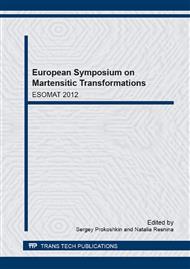p.137
p.143
p.150
p.155
p.160
p.167
p.172
p.177
p.183
Implementation of Likhachev’s Model into a Finite Element Program
Abstract:
Shape memory alloys have become very popular over the past few decades, mainly as actuators or superelastic devices. Their complex behavior complicates the design process of these applications, and several models have been developed to assist design engineers in this endeavor. One of these models, the structure-analytical theory proposed by Likhachev, is particularly attractive because it is physically grounded and capable of dealing with tensorial stress and strain states. Unfortunately, its stress-controlled formulation has hindered its implementation in displacement-based finite element programs. This paper presents an adaptation of Likhachev’s model leading to a strain-controlled formulation based on an iterative algorithm and a proportional controller. The resulting model is implemented in ANSYS and a simple finite element analysis is carried out to illustrate its appropriate functioning.
Info:
Periodical:
Pages:
160-164
Citation:
Online since:
January 2013
Authors:
Price:
Сopyright:
© 2013 Trans Tech Publications Ltd. All Rights Reserved
Share:
Citation:


